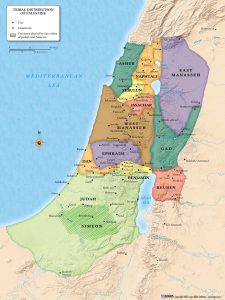THE THREE most important things when considering real estate are location, location, and location.
This week, we discuss the request of the tribes of Gad and Reuben and the half-tribe of Manasseh to remain east of the Jordan in Gilead and Bashan. Then we recount the stations of the Exodus and explain why certain locations, especially Oboth and Iye-Abarim, were so important.
Finally, we run down a rabbit trail connecting the supernatural nature of those locations to research for Derek’s forthcoming book, The Second Coming of Saturn, recent work by Dr. Judd Burton tracing the origins of Eurasian words for “king” or “ruler” to the Ararat Plain, and the widespread practice of summoning spirits from the netherworld in and around ancient Canaan.
Cancel the cancellers! Subscribe to the new SkyWatchTV channel at Rumble: www.rumble.com/skywatchtv.
NOTE: New dates for our tour of Israel! We will lead our next tour through the Holy Land March 25–April 3, 2025, with an optional three-day extension to Jordan featuring visits to Mount Nebo, Wadi Rum, and Petra. Our special guests are Timothy Alberino, Dr. Judd Burton, and Doug Van Dorn!
For more information, log on to www.GilbertsInIsrael.com.
Our book Giants, Gods & Dragons is available in Kindle and paperback! Get it as part of a great package with more than 27 hours of our video teachings at the SkyWatchTV Store or at Amazon.com.
Click here for the complete archive of our New Testament Bible studies to date, and click here for the Old Testament studies to date. Or go to www.spreaker.com/show/gilbert-house-fellowship for all of the audio.


Doesn’t Ararat mean “the curse reversed”?
Don’t eat the salad. My Chinese mum in law taught me how to stir fry lettuce, drop of water, sprinkling of fried garlic and oyster sauce on top. You can’t trust how clean the water is, or what they put in it. Don’t eat anything raw.
ASIA, ISRAEL, WORLD
THE FIRST-EVER PORTRAIT OF JESUS CHRIST IN ISRAEL DISCOVERED, 70 ANCIENT BOOKS HIDDEN IN A CAVE FOR NEARLY 2,000 YEARS
NOVEMBER 7, 2020 ARCHAEOLOGY WORLD TEAM LEAVE A COMMENT
SHARE THE ARTICLE
4
The first-ever portrait of Jesus Christ in Israel Discovered, 70 ancient books hidden in a cave for nearly 2,000 years
The image is eerily familiar: a bearded young man with flowing curly hair. After lying for nearly 2,000 years hidden in a cave in the Holy Land, the fine detail is difficult to determine. But in a certain light, it is not difficult to interpret the marks around the figure’s brow as a crown of thorns.
The extraordinary picture of one of the recently discovered hoards of up to 70 lead codices – booklets – found in a cave in the hills overlooking the Sea of Galilee is one reason Bible historians are clamouring to get their hands on the ancient artefacts.
If genuine, this could be the first-ever portrait of Jesus Christ, possibly even created in the lifetime of those who knew him.
The first-ever portrait of Jesus Christ in Israel Discovered, 70 ancient books hidden in a cave for nearly 2,000 years
Discovery: The impression on this booklet cover shows what could be the earliest image of Christ
The tiny booklet, a little smaller than a modern credit card, is sealed on all sides and has a three-dimensional representation of a human head on both the front and the back. One appears to have a beard and the other is without. Even the maker’s fingerprint can be seen in the lead impression. Beneath both figures is a line of as-yet undeciphered text in an ancient Hebrew script.
Astonishingly, one of the booklets appears to bear the words ‘Saviour of Israel’ – one of the few phrases so far translated.
The owner of the cache is Bedouin trucker Hassan Saida who lives in the Arab village of Umm al-Ghanim, Shibli. He has refused to sell the booklets but two samples were sent to England and Switzerland for testing.
An investigation has revealed that the artefacts were originally found in a cave in the village of Saham in Jordan, close to where Israel, Jordan and Syria’s Golan Heights converge – and within three miles of the Israeli spa and hot springs of Hamat Gader, a religious site for thousands of years.
Precious: This booklet shows what scholars believe to be the map of Christian Jerusalem
According to sources in Saham, they were discovered five years ago after a flash flood scoured away the dusty mountain soil to reveal what looked like a large capstone. When this was levered aside, a cave was discovered with a large number of small niches set into the walls. Each of these niches contained a booklet. There were also other objects, including some metal plates and rolled lead scrolls.
The area is renowned as an age-old refuge for ancient Jews fleeing the bloody aftermath of a series of revolts against the Roman empire in the First and early Second Century AD.
The cave is less than 100 miles from Qumran, where the Dead Sea Scrolls were discovered, and around 60 miles from Masada, scene of the last stand and mass suicide of an extremist Zealot sect in the face of a Roman Army siege in 72AD – two years after the destruction of the Second Temple in Jerusalem.
It is also close to caves that have been used as sanctuaries by refugees from the Bar Kokhba revolt, the third and final Jewish revolt against the Roman Empire in 132AD.
The era is of critical importance to Biblical scholars because it encompasses the political, social and religious upheavals that led to the split between Judaism and Christianity.
It ended with the triumph of Christianity over its rivals as the dominant new religion first for dissident Jews and then for Gentiles.
In this context, it is important that while the Dead Sea Scrolls are rolled pieces of parchment or papyrus containing the earliest-known versions of books of the Hebrew Bible and other texts – the traditional Jewish format for written work – these lead discoveries are in book, or codex, a form which has long been associated with the rise of Christianity.
The codices seen range in size from smaller than 3in x 2in to around 10in x 8in. They each contain an average of eight or nine pages and appear to be cast, rather than inscribed, with images on both sides and bound with lead-ring bindings. Many of them were severely corroded when they were first discovered, although it has been possible to open them with care.
The codex showing what may be the face of Christ is not thought to have been opened yet. Some codices show signs of having been buried – although this could simply be the detritus resulting from lying in a cave for hundreds of years.
Unlike the Dead Sea Scrolls, the lead codices appear to consist of stylised pictures, rather than text, with a relatively small amount of script that appears to be in a Phoenician language, although the exact dialect is yet to be identified. At the time these codices were created, the Holy Land was populated by different sects, including Essenes, Samaritans, Pharisees, Sadducees, Dositheans and Nazoreans.
One lucky owner: Hassan Saida with some of the artefacts that he says he inherited
There was no common script and considerable intermingling of language and writing systems between groups. Which means it could take years of detailed scholarship to accurately interpret the codices.
Many of the books are sealed on all sides with metal rings, suggesting they were not intended to be opened. This could be because they contained holy words which should never be read.
I just copy and pasted and article but it did not copy and paste the picture’s. I have booked marked but not sure how to share it. It’s an interesting article. Steve Quayle posted a article from the Archaeologyworld.com that showed a painting of a giant carrying 2 elephants and I scrolled down and happened to see this article. Pretty fascinating, I wish I could share the whole article with pictures
https://archaeology-world.com/the-first-ever-portrait-of-jesus-christ-in-israel-discovered-70-ancient-books-hidden-in-a-cave-for-nearly-2000-years/
The link from the above comments.